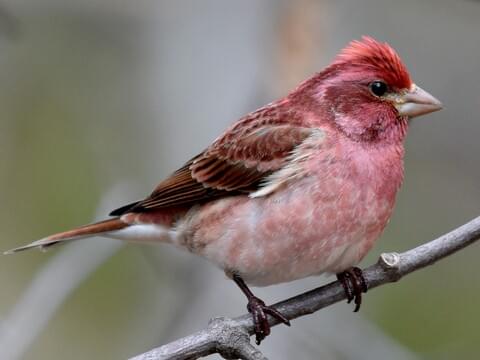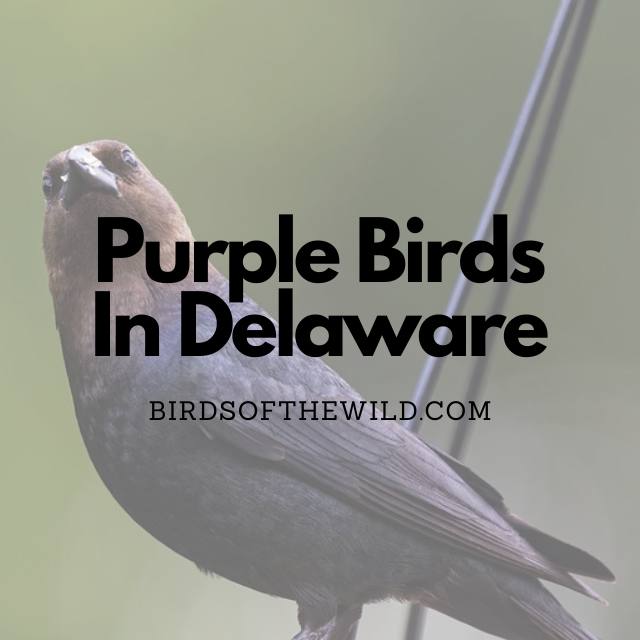In this article I’ll be going over 5 purple birds that can be found across the state of Delaware so, continue reading for a more detailed look at each bird below.
- Rock Pigeon
- Purple Martin
- Brown Headed Cowbird
- Purple Finch
- European Starling
5 Purple Birds In Delaware
1. Rock Pigeon (Columba Livia)

- Size: 30 – 36cm
- Weight: 265 – 380 grams
- Wingspan: 50 – 67cm
You’ll find rock pigeons scattered all across Delaware on a year round basis.
Rock pigeons are mostly gray with elements of black on their wings and green plus purple hue across their neck. Females are generally smaller in size and also have a flatter head unlike the males who tend to have a more round head shape.
These pigeons spend the majority of their time around urban parks and neighborhoods, around farms, under highway, railroad bridges as well as near tall rocky cliffs.
In regards to the food rock pigeons eat, they include a variety of seeds, bread crumbs, seed grasses, worms among other insects, berries and acorns.
Rock pigeons tend to live for 6 years in the wild when averaged out.
2. Purple Martin (Progne Subis)

- Size: 19 – 20cm
- Weight: 45 – 60 grams
- Wingspan: 39 – 41cm
You’ll find purple martins in all of Delaware throughout their spring and summer breeding months.
Purple Martins are recognised by their almost entirely purple plumage with the wings and lower half of their body purple, and the remainder a darker blue color. Females on the hand are mostly white and gray with hints of blue on their plumage.
As for where these birds live, it tends to be around open locations that are at least 40 ft. from trees or buildings so, you’ll often see them perching on utility wires and houses throughout the local Texan neighborhood.
Purple Martins tend to eat mostly flying insects like house flies, crane flies, beetles, moths, butterflies and even dragonflies. Dragonflies in particular are a very important part of their diet.
These avians have been known to live for 13 years but, the average for most probably wouldn’t surpass 6 – 7 years.
3. Brown Headed Cowbird (Molothrus Ater)

- Size: 16 – 20cm
- Weight: 38 – 45 grams
- Wingspan: 32 – 38cm
Brown headed cowbirds can be found across Delaware on a yearr round basis.
These birds can be recognised by their light brown head, their dark blue/purple wing and body feathers. Females are mostly brown in color.
As for where brown headed cowbirds tend to spend the majority of their time, it would include open grasslands, as well as agricultural, urban, and suburban habitats where grain or cattle-disturbed soil are readily available.
Brown headed cowbirds mostly consume mostly insects like grasshoppers, beetles, spiders, flies etc as well a number different seeds.
These cowbird are known to live for around 17 years in the wild on the high end.
4. Purple Finch (Haemorhous Purpureus)

- Size: 15 – 16cm
- Weight: 24 – 26 grams
- Wingspan: 25 – 26cm
You’ll find purple finches throughout Delaware in their fall and winter non-breeding seasons.
Purple finches are recognised by their pinkish plumage with hints of purple throughout, their mohawk like head feathers and gray beak. Females on the other hand are mostly brown with the brown color patterned throughout.
These finches can be found in coniferous and mixed woods, both in forest interior and along edges. They also tend to breed near oak trees and streamsides.
Purple finches tend to eat a variety foods from insects, small fruits, berries and seeds, with seeds being their go to food source.
The average lifespan for these birds is around 3 – 4 years though many are also able to live till 6 or 7 years of age.
5. European Starling (Sturnus Vulgaris)

- Size: 20 – 23cm
- Weight: 60 – 96 grams
- Wingspan: 31 – 40cm
European starlings were first introduced to north America in the early 1890’s. Now they can be found throughout the state of Delaware.
These starlings are recognised by their multi colored plumage which is made up of purple, green, blue and gray. The head and neck are purple with hints of green, their wings green and gray, the belly and breast blue and green with the beak a striking yellow color. Females on the other hand are mostly a light brownish/gray color.
European starlings can often be found around people, using mowed lawns, city streets, and agricultural areas like city parks as their place of rest.
As for what they eat, it includes worms, snails, insects, fruit and seed mixes. They do also forage for food around soil and rocks.
European starlings are known to live for around 2 – 3 years on average in wild, whilst the number is much higher in captivity achieving a max of 20 years within such an environment.
Amhil Khan, a dedicated nature enthusiast and the founder of BirdsOfTheWild.com, is a passionate advocate for the captivating world of avian wonders. With a deep-seated curiosity about the intricate lives of birds, Amhil’s journey began as a fascination and has evolved into a mission to inspire others to appreciate and protect these magnificent creatures.
Amhil’s love for birds led to the creation of Birds of the Wild, a platform where his expertise in ornithology, coupled with his captivating storytelling, provides readers with an immersive and educational experience. Through his lens and words, he captures the essence of birds in their natural habitats, offering a glimpse into their behaviors, migrations, and the ecosystems they inhabit.

